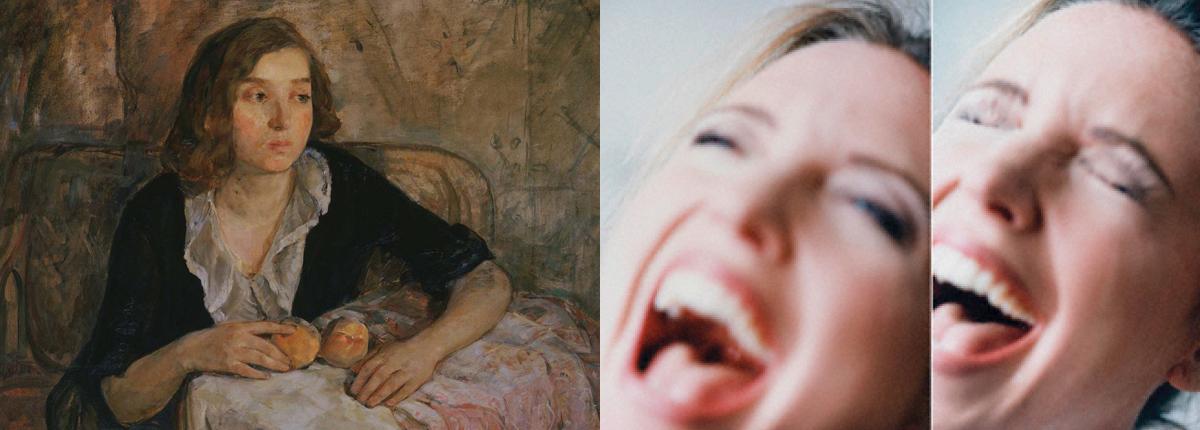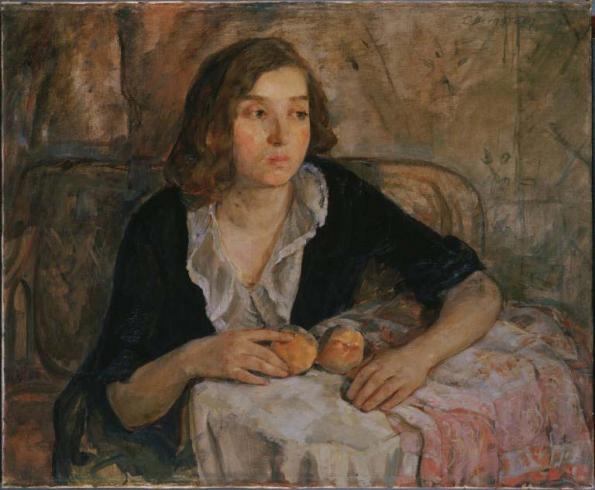Femininity and Identity

Part 1: Close Looking
With your students, conduct the following close looking exercises:
- Look closely at each artwork, Girlhood and Cry Laughing, and then describe each artwork in one word, based on their first impression.
- Mimic the facial expressions in both works. Try to get them to move their face and body so that they mirror the gestures of the figures in the artworks.
- Reflect:
- How did you feel making those facial expressions?
- Did you get a sense for what the person in the artwork is feeling?
- Why might the woman be feeling that way? How can you tell?
Describe:
- Based on their experience with mimicking the facial expressions, have them describe each artwork in one word, again.
- Have students think about why they chose this descriptive word.
- Reflect:
- What do these women’s facial expressions and gestures tell you about their identity?
- Do you feel like you can really know what a person is feeling based only on looking at them? Why or why not?
Compare:
- Compare their one-word descriptions in a small group:
- How were your words similar and different, both before and after you mimicked the expressions?
- Why, if at all, did your one-word descriptions change through this exercise?
- Reflect:
- How did mimicking the expressions make you think differently about what you saw in the artworks?
Part 2: Making Connections
CONNECT the artworks:
- Have the students compare the two artworks:
- How are the two artworks similar? How are they different?
- Have the students consider the materials, composition, how the people in the artwork are framed, and the subject matter.
- Explain to students some context about each of the artworks:
- Girlhood is an image of Theresa Bernstein’s husband William Meyerowitz’s younger sister Minna (i.e., her sister-in-law). Minna, along with her four siblings and mother, was financially dependent on William and Theresa in 1921. While visiting William and Theresa, Minna posed in a studio near their home, her hands placed near three peaches. The fruit, wrote Bernstein, signified “the three stages of life—youth, development, and maturity. The green peach, the partly blooming peach, and the fully ripened peach represented the full cycle of the fruit’s ripening.”
- Cry Laughing was made in 1997, the year Sam Taylor-Johnson was diagnosed with colon cancer. Her photographs respond directly to the artist’s personal experience with facing her mortality (knowing that she will die one day).
- Have the students reflect on how the artists consider the following themes:
- Identity
- Femininity
- Stages of life
- Humanity/mortality
CONNECT to the human life cycle:
- Ask the students to consider how the artworks connect to the human life cycle:
- How do you see the human life cycle depicted in these works?
- What do you see in the artworks that makes you say that?
- Then, compare how human life cycles compare to that of animals:
- What are some life cycles of other animals?
- Students should select one animal’s life cycle and compare its stages with that of a human’s.
Part 3: Stages of Life
- Have the students write a list with multiple stages of their life that they have experienced. Try to get them to be creative; the stages can expand beyond scientific classifications.
- Students should take a series of selfies to depict at least three stages of their life on their list.
- Try to get them to show their emotions like Taylor-Johnson’s photographs.
- Have them experiment with incorporating props like Bernstein’s portrait of her sister-in-law.
Reflect:
- Have each student share their photos with a partner.
- Each partner should write down one word to describe each of their partner’s selfies.
- How do their partner’s interpretations compare with the life stages they had written for their original list?
- How do the photographs show something about the person’s identity?
Additional Context
Lesson Context
Sam Taylor-Johnson
- Sam Taylor-Johnson is an English filmmaker, photographer, and visual artist.
- In her highly choreographed photographic and filmic scenes, Taylor-Johnson examines inner states of being, such as emotional isolation, vulnerability, self-absorption, anguish, but also social confrontation.
- She has been diagnosed with both colon and breast cancers and has responded to her personal experiences with mortality through her works.
Theresa Bernstein
- Throughout her career, Theresa Bernstein sought to paint the humanity she saw in the world.
- As a champion of women and a strong supporter of the suffrage movement, her work closely examined the very real, raw, and varying emotional aspects of womanhood.
- Bernstein portrays women with dignity and individuality, demonstrating their goals and accomplishments.
- Bernstein characterized her sister-in-law with tenderness, which is evident not only in Minna’s facial expression, but in the soft light and feathery brushwork she uses. Lost in thought, Minna appears to be at a crossroads in life; leaning on the table and touching the green peach, she seems curiously reticent, as if afraid to make the next move.
Key Terms
Femininity: Qualities historically associated with woman and girlhood; however, this has expanded over time to include a more diverse set of gender expressions.
Identity: An individual’s distinguishing characteristics.
Life Cycle: The series of changes over time in any living organism (e.g., human being, animal, or plant).

